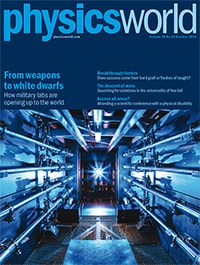 By Matin Durrani
By Matin Durrani
The cover story in the October 2016 issue of Physics World magazine – now live in the Physics World app for mobile and desktop – reveals the inside story of how military labs are opening up their research facilities to the world. You can read the article here too.
The October issue also looks at how breakthroughs in physics really occur – is it flashes of insight or just long, hard graft? – and examines why we could finally find discrepancies in the “equivalence principle” that inertial and gravitational mass are the same.
Don’t miss either the ding-dong over China’s plans to build a new collider, our interview with Nithaya Chetty on transforming South African astronomy, or Robert P Crease’s Critical Point column on the danger of “unknown unknowns”.
If you’re a member of the Institute of Physics (IOP), you can now enjoy immediate access to the new issue with the digital edition of the magazine in your web browser or on any iOS or Android mobile device (just download the Physics World app from the App Store or Google Play). If you’re not yet in the IOP, you can join as an IOPimember for just £15, €20 or $25 a year to get full access to Physics World digital.
For the record, here’s a run-down of what else is in the issue.
• Nobel winner criticizes China collider – Chen Ning Yang, who shared the 1957 Nobel Prize for Physics, has openly questioned whether China should build a Higgs factory. But others disagree, as Ling Xin reports
• Transforming African astronomy – As South Africa’s MeerKAT radio telescope begins producing its first results, Manisha Lalloo meets physicist Nithaya Chetty, deputy chief executive officer of astronomy for the country’s National Research Foundation, about how it can boost research in the region
• Using history to teach physics – Cameron Reed describes how he uses the Manhattan Project as a way to introduce students to scientific concepts and issues
• Unknown unknowns – People who raise “unknown unknowns” to promote a particular course of action – such as closing particle colliders – are doing a disservice to science, says Robert P Crease
• The descent of mass – The simultaneous drop of two dissimilar masses is one of the oldest experimental results. But as Jon Cartwright reports, new techniques may show that not everything falls the same way
• In search of claritons – Do breakthroughs in physics occur through sudden “light-bulb moments”, or are they more often the result of solid, hard graft? Philip Ball talks to physicists who have experienced success to find out
• From weapons to white dwarfs – Military research centres that use giant lasers to study
conditions inside nuclear warheads are increasingly opening their doors to university scientists. Edwin Cartlidge asks what the labs and the researchers have to gain from the arrangement
• The struggle for convergence – Manjit Kumar reviews Convergence: the
Deepest Idea in the Universe by Peter Watson
• Finding the right boundaries – Chanda Prescod-Weinstein reviews Fashion, Faith and Fantasy in the New Physics of the Universe by Roger Penrose
• Graduate careers: Taking the long view – A new study of the long-term employment prospects of UK science and engineering students suggests that talk of a skills shortage is overblown, with most graduates in these disciplines taking jobs outside science. Researchers Patrick White and Emma Smith discuss their findings and what they mean for current physics students
• Putting my foot down – Margaret Harris on attending a conference with a physical disability



